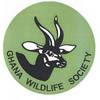Dr Danaë Sheehan writes: On arriving in the small town of Damongo we checked into the Home Touch Guesthouse, which the team will be using as a base whilst working in the area. Emmanuel Koduah had joined us from GWS in Accra to become the fifth and final member of the team in Ghana. Eric (a qualified and experienced chef as well as the driver), quickly set up a kitchen on the veranda, from where he produced his culinary specialities. After settling in at the guesthouse (which included evicting a small Monitor Lizzard from Nat's shower), our task here was to locate the ransects for point counts and set up two constant effort sites (CES) for mist-netting.

Phil and I had identified a few suitable areas back in May, which Chris, Nat, Emmanuel and I used as starting points. Our first CES site and the start of one of the transects was set up in the Damongo Scarp Forest Reserve, the boundary of which starts about 8 km before Damongo, with the reserve lying to the north of the road. The reserve continues along the northern side of the road, the far boundary being only 1 km from Damongo town. The reserve has a distinct feel of an English woodland with a good density of medium height trees, although bird density is surprisingly low. Despite being a reserve, there is evidence of timber extraction for charcoal, and also quite a number of planted non-native teak trees.
We located our second CES site among some remnant patches of acacia woodland with fairly dense undergrowth nearby to the main dam on the edge of town Here, much of the shore is farmed by local market gardeners, although further away from the shore there is quite extensive maize planting, and of course the ever present (and highly mobile) livestock grazing.
We then moved on to another forest reserve (KeniKeni) about half an hours drive from Damongo and contiguous with Mole NP. Being further from a settlement, Kenikeni FR represents a good example of a more pristine Guinea savannah woodland. With pristine habitat well represented, we also set up transects in the surrounding farmed areas so that we could look at how birds use a range of habitats along a degradation gradient.







No comments:
Post a Comment
Note: only a member of this blog may post a comment.